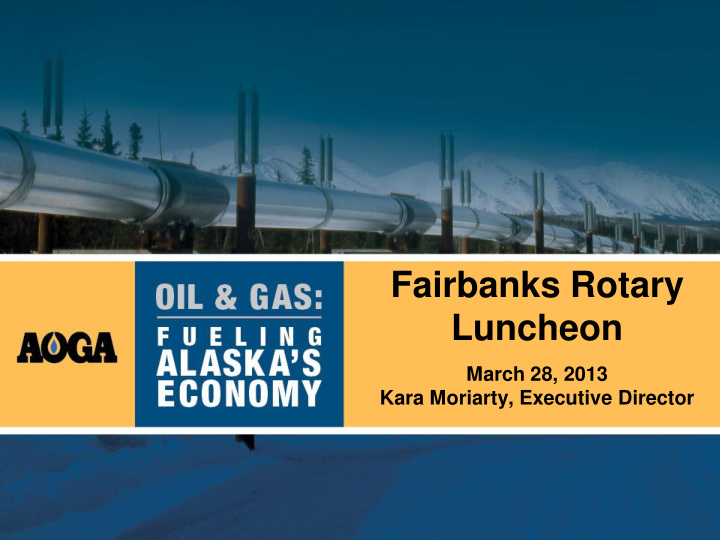



Fairbanks Rotary Luncheon March 28, 2013 Kara Moriarty, Executive Director
Alaska Oil and Gas Association Purpose • Serve as single point of contact for Alaskans on the state’s oil and gas industry • Provide a forum for discussion and a point of decision on issues that affect the industry Mission Long-term viability of the Alaska’s Oil & Gas Industry for the benefit of all Alaskans
AOGA Member Companies
Oil & Gas Has been Good to Alaska – Jobs & Revenue State of Alaska has collected $160+ billion from oil & gas since 1959 • Oil & gas continue to dominate state’s unrestricted revenue, accounting for 93% ($8.8 billion) in FY 2012 • State estimates 90% of its revenue will continue to come from oil and gas – even with falling production Industry creates jobs and provides income for many • 44,800 jobs and $2.65 billion in annual payroll (does not include State jobs, or jobs related to capital budgets) • 1 = 9 - Nine oil industry-related jobs created in Alaska for every primary company job
C O M M U N I T Y
How Did we Get Here? • Alaska’s Tax Policy Has Changed Substantially Over the Years – Pre 2005: Gross System w/Economic Limit Factor (ELF) • Recognized challenging economics as fields declined – 2006-2007: Net System: Petroleum Production Tax (PPT) • Net system to create incentives for exploration/development • Increased state revenue as prices rise, regardless of size of field or production • More than doubled taxes – 2007-Today: Net System: (ACES) • Still Net System • Increased progressivity rates/added complicated regulations • More than doubled taxes..again.
Where Are We?
Production Decline Is Real
Competition at High Oil Prices
Alaska Headed Out of Medal Contention – 4th
Alaska Contributing 8% of U.S. Oil Production
A Grim Future Without Oil & Gas Sources of FY 2012 Unrestricted Revenue Oil and Gas Royalties & Taxes ($8.8B) 93% Excise Taxes ($170.8M) 2% Corporate Income Taxes ($98.5M) 1% Licenses & Permits ($42.3M) less than 1% Mining Taxes ($40.7M) less than 1% Fisheries Taxes ($32.7M) less than 1% Source: Alaska Department of Revenue – Fall 2012 Sources Book
What does Alaska look like in 10 years? Scott Goldsmith, Institute of Social and Economic Research, UAA, "Maximum Sustainable Yield: FY 2014 Update," Web Note 14 , January 2013
A Grim Future Without Oil & Gas Scott Goldsmith, Institute of Social and Economic Research, UAA, "Maximum Sustainable Yield: FY 2014 Update," Web Note 14 , January 2013
Governor Lays out Principles for Oil Tax Reform Anchorage Daily News, Jan. 6, 2013: Reform must: • Be fair to Alaskans • Encourage new oil production • Be simple and restore balance • Be durable and long-term in nature
Governor Lays out Principles for Oil Tax Reform Anchorage Daily News, Jan. 6, 2013: Reform must: • Be fair to Alaskans • Encourage new oil production • Be simple and restore balance • Be durable and long-term in nature • AOGA Recommendation: Avoid changes that artificially creates “winners & losers”
AOGA Supports Components of CSSB 21 (FIN) am(efd fld) Cornerstone for significant and crucial tax reform – Support the elimination of progressivity – Support the concept of gross revenue exclusions – Support the transferability of loss carry forward credits – Support the manufacturing credit – Support lower statutory interest rate
AOGA Concerns with CSSB 21 (FIN) am(efd fld) • Base tax rate is too high • Serious concerns with how the bill addresses tax credits (QCE elimination, no extension of small producer and exploration credits) • Does not support the Competitiveness Review Board • Gross Revenue Exclusions for legacy fields needs clarity and certainty. • Identified other ways to improve policy (repeal minimum tax, and allow DOR to use joint-interest billings)
Work Together. Win Together. • Alaska Needs a Strong Oil Tax Policy that achieves production from new & legacy fields • Continue to evaluate the bill to look for ways to accomplish Gov.’s Goals • Stand ready to assist in achieving long-term policy for Alaska
Recommend
More recommend